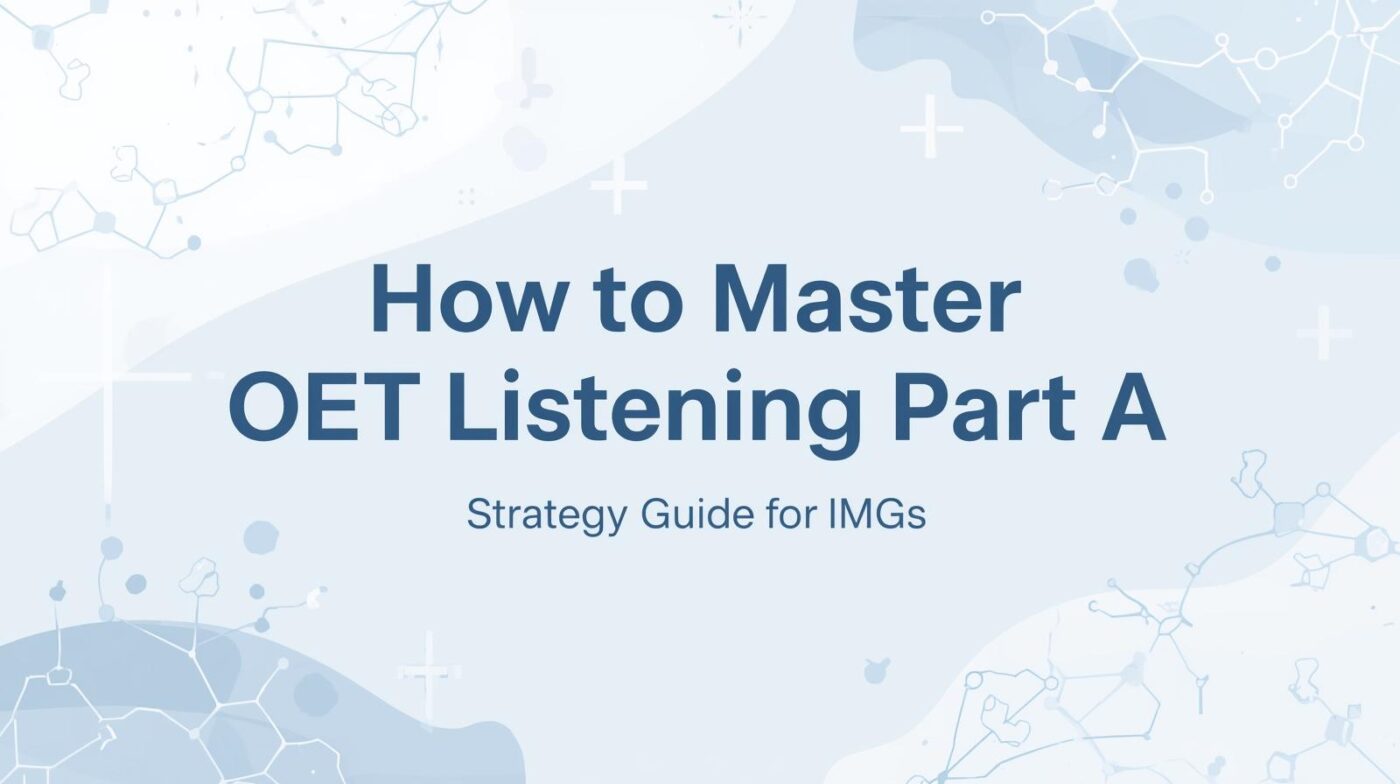OET Strategies
Why OET Listening Part A Feels So Hard — and How to Finally Understand It
For many test-takers, the most challenging part of the OET exam is the Listening section — especially Part A.
For IMGs who have mainly studied “exam-style” English in their home countries, this part can feel nearly impossible on first attempt. The accent, the pace, and the way information is presented can be overwhelming.
Unlike American English, OET recordings often feature varied accents—particularly Australian, British, or even elderly speakers whose pronunciation can be quite difficult to follow. The audio moves fast and offers little time to process.
Compared with other English exams such as IELTS or TOEFL, OET Listening feels more complex because it simulates real healthcare communication rather than testing general listening skills.
To reach your target score, it’s essential to understand what the test is actually measuring — and how to train for it effectively.
The Core Skill: Understanding “Paraphrase Gaps”
At its heart, Listening Part A tests your ability to bridge the gap between what you hear and what appears on the question paper.
This “gap” — where two different expressions refer to the same idea — is known as paraphrasing.
All major language proficiency tests use paraphrase as a foundation. OET is no exception.
For example, imagine you hear in the audio:
“I’ve had trouble sleeping over the past few months.”
On your notes page, you might not see the phrase sleep problem directly. Instead, the correct answer could appear as one of these equivalents:
- Insomnia
- Sleeplessness
- Restlessness
- Wakefulness
- Disturbed sleep
The goal isn’t to test whether you can hear each word perfectly. It’s to assess whether you can understand meaning — to recognize that different words can express the same clinical concept.
Once you understand this principle, predicting correct answers becomes much easier. You begin to “see through” the vocabulary and focus on what the speaker means, not just what they say.
Why IMGs Often Struggle with This Skill
Many IMGs have strong medical knowledge and even large English vocabularies. In fact, research shows that non-native healthcare professionals often know thousands of technical terms from textbooks or journals.
However, the real challenge lies elsewhere: interpreting reworded expressions quickly.
For example, a native-trained listener hears “difficulty sleeping” and immediately links it to insomnia without translation. But many IMGs subconsciously translate into their first language before interpreting — which slows down comprehension and causes missed details.
In short, success in OET Listening isn’t about intelligence or effort; it’s about re-training your brain to process meaning directly in English.
Try to keep your thinking simple:
“This phrase in the audio is just a rephrased version of that line in the notes.”
Once you approach it this way, the examiner’s logic becomes visible — and the test starts to feel more predictable.
Common Patterns and Strategy Points for Listening Part A
Listening Part A follows consistent patterns.
If you understand these, your performance improves dramatically.
Here are three key features to focus on:
- Paraphrased keywords and context recognition
- Extracting specific factual details
- Recognizing distractors
1. Paraphrased Keywords and Context Recognition
The biggest feature of Part A is that the audio almost never repeats the exact words from the question sheet. Instead, phrases are restructured or replaced with synonyms.
For example, the notes may read:
“Patient’s description of symptoms: pain described as ______.”
In the audio, the speaker might say:
“The pain feels like a burning sensation.”
To succeed, you must identify not only individual words but the semantic category — the underlying idea (e.g., type of pain).
Rather than focusing on isolated sounds, train yourself to grasp the bigger picture: what kind of information is being conveyed.
2. Extracting Specific Information
The blanks in the notes usually require concrete information — such as nouns, names, or detailed descriptors.
Sometimes the necessary detail is surrounded by extra or unnecessary information. The speaker might mention several options or elaborate in a long sentence.
Your job is to filter all that and capture the single fact that fits logically into the notes.
Link this back to paraphrase awareness: ask yourself which piece of information directly matches the question structure.
3. Identifying and Avoiding Distractors
Part A transcripts often include misleading elements called distractors — information that sounds relevant but is intentionally incorrect.
Examples include:
- Treatments the patient tried but found ineffective
- Diagnoses that were considered but ruled out
- Medications that were mentioned but not prescribed
For instance, if the patient says,
“I was thinking of trying acupuncture, but I didn’t in the end,”
and your notes say Treatment attempted: ______,
then the correct answer is not “acupuncture.”
You must choose what the patient actually did, not what they only mentioned.
Recognizing these distractors requires critical listening — distinguishing between what’s discussed and what’s confirmed as true.
Bringing It All Together
When viewed as a whole, OET Listening Part A isn’t just a “hearing” test.
It evaluates your ability to process and organize clinical information — exactly what healthcare professionals do in real consultations.
Its two defining features are:
- The logical structure of case notes
- The paraphrasing used in spoken responses
If you shift your focus from “I can’t catch the words” to “I can map meaning onto structure,” your progress will accelerate noticeably.
Listen with intention. Watch for rephrasing. And always connect sound with concept.
If you’re preparing for OET, consider exploring our practice resources at OET Bank.
We’re designed not just as mock tests, but as powerful review tools that make it easier to analyze weaknesses and focus on what’s needed to pass.


